Top News
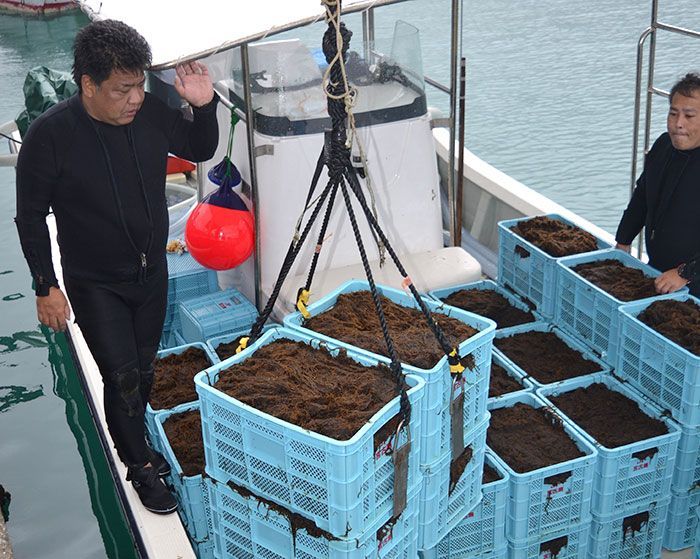
January 20, 2022 Ryukyu Shimpo
By Shinji Sano
Miyakojima – The earliest mozuku harvest in Okinawa has begun in Miyakojima. On January 19 at Oura Fishing Port in Hirara, Miyakojima, fishermen unloaded basket after basket of glittering, dark green mozuku seaweed. Koji Kuriyama, head of the Miyakojima Fishery Cooperative, which oversees operations, said smiling, “[The seaweed] has a great color, this is a prime result. I want to ship this out to Okinawans as soon as possible.”
The harvested mozuku has been dubbed Okinawa mozuku, a branding effort being undertaken by the Miyakojima Fishery Cooperative and the Miyakojima Marine Industry Center. Local fishermen in Hisamatsu, Miyakojima have provided the cooperative with the name “Kima-kabu”’ for the locally produced bunches of seaweed. The bunches have longer and thicker stems than regular mozuku, have no smaller stems, and have a crunchier mouth feel.
On January 19, fisherman Akiyuki Ikeda, who brought in around 1.5 tons of mozuku, said, “We were worried about the damage caused by the pumice stone and tsunami, but it was good that we were able to harvest without incident. [The mozuku] is thick and high quality.”
The mozuku harvest in Miyakojima will continue until around April. The Miyakojima Fishery Cooperative usually ships around 1,000 tons of mozuku in a regular year. Co-op president Kuriyama says,” we are forecasting shipments totaling around 1,200 tons this year. The taste is good, and we have high expectations.”
(English translation by T&CT and Sam Grieb)
Go to Japanese
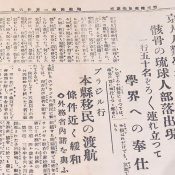
January 19, 2022 Ryukyu Shimpo
By Kazuki Furugen
The fifth annual Junkudo New Year Antiquarian Book Fair, an event where antiquarian booksellers gather to show off and market rare books and historical documents, will be held from January 29 through Mar 6 at the Junkudo Bookstore in Naha City. The event is sponsored by the All-Okinawa Antiquarian Booksellers Association. Visitors of this year’s book fair will be able to find an original copy of a January 26, 1929 Ryukyu Shimpo article describing how the Kyoto Imperial University research team appropriated human remains from the Mumujana Tomb, an exposure burial site in Unten, Nakijin Village.
The item is invaluable, as the current Ryukyu Shimpo does not hold a print copy of the article and the Prefectural Archive only holds the electronic scan. The headline of the news piece describing the expatriation of the Ryukyuan remains reads: “Contribution to Kyoto University’s Department of Anthropology; Ryukyuan remains discovered.” Currently, Kyoto University is mired in a lawsuit over the repatriation of those remains. However, the 1929 article uses phrases such as “service to the academic world,” suggesting the exhumation was not viewed as problematic at the time.
Visitors of this year’s book fair will also find the “Chuzan Denshin Roku,” a written record of the Chinese vice-envoy, Xu Buguang’s visit to the Ryukyus in 1719. While the historical document has been reprinted in China and Japan, the 1766 edition stored at Shuri Castle was destroyed in the 2019 fire. The Chuzan Denshin Roku that will be available at the Junkudo book fair is believed to have been published the same year.
For inquiries, contact the Junkudo Shoten Naha Branch at 098-860-7175.
(English translation by T&CT and Monica Shingaki)
Go to Japanese
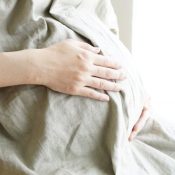
January 21, 2022 Ryukyu Shimpo
By Takuya Kayo
New cases of COVID-19 are spreading among all age groups, and one group in which cases are surging is pregnant individuals. During the fifth wave of infections between August 1-29 of last year, 162 pregnant individuals contracted COVID 19. As of January 20 of this year, the number of pregnant COVID-19 patients was 184. Twenty-one of these individuals were hospitalized as of January 19.
In addition to the handling of general COVID-19 cases, for pregnant patients, major medical facilities partner with each individual’s primary OB-GYN to create a system that can provide medical examinations. Doctor Keiko Mekaru is the head of the perinatal and maternal care center at the University of the Ryukyus Hospital. She encourages patients to be calm, saying, “Even if you are pregnant and test positive or are in close contact with a COVID-positive individual, don’t panic. Consult your primary doctor.”
Since the start of the pandemic, 564 pregnant people have contracted COVID-19. Further analysis is required to say whether these individuals are at increased risk of severe COVID.
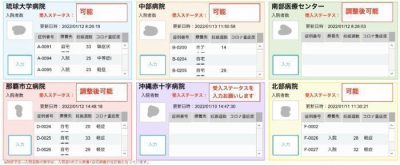
The database that monitors pregnant individuals who have been admitted to hospitals in Okinawa (Provided image)
After consulting their primary doctor, the pregnant individual will be sent to a designated hospital for the infectious disease if there is obstetric risk. The hospital staff will determine whether the individual should be hospitalized or recuperate at home on the basis of their COVID symptoms and whether there is a chance of preterm delivery. Individuals who need to give birth are sent to Okinawa Chubu Central Hospital or to the University of the Ryukyus Hospital.
The Okinawa Prefectural Nambu Medical Center and Children’s Medical Center and the Okinawa Red Cross Hospital are accepting pregnant individuals with risks other than COVID-19. These partnerships are the result of independent work by the Okinawa Society of Obstetrics and Gynecology and the Okinawa Association of Obstetricians and Gynecologists. There have been inquiries from other prefectures regarding the partnerships.
Doctor Mekaru says, “Pregnant individuals and their families should behave in such a way that they won’t be infected. I also hope that pregnant individuals will consider getting the vaccine, because we expect the vaccine to be effective at preventing severe COVID-19, even against the Omicron variant.”
(English translation by T&CT and Ellen Huntley)
Go to Japanese
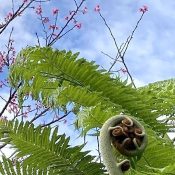
January 18, 2022 Ryukyu Shimpo
By Yuki Karimata
The Okinawa Meteorological Observatory announced in the “Early weather report concerning heat” that the Okinawa region would experience a gentle pressure system with high barometric pressure to the west, with a low-pressure system to the east, bringing in warm and wet air from the south, leading to hot weather through January 23-24. They are forecasting highs of around 24-25° C, and that the warm weather will carry through the end of the month. The observatory is cautioning people to take care with their crops.
According to JA Okinawa, depending on the type of agricultural product, the stretch of warm weather could affect the time period for harvesting.
(English translation by T&CT and Sam Grieb)
Go to Japanese
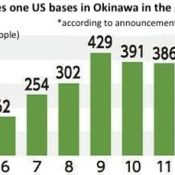
January 13, 2022 Ryukyu Shimpo
By Ryota Nakamura
The number of people newly infected with the novel coronavirus on January 12 on U.S. military bases in Okinawa came to 295 people. According to calculations by this newspaper, when calculating the number of newly-infected people in the past week per 100,000 people, the number comes to 4,691.3 people. When comparing numerical values, this number is 7.84 times the 598.27 per 100,000 people throughout all regions of Okinawa, which is confirmed as having the most coronavirus cases domestically, 4.2 times the 1113.04 per 100,000 people in Miyakojima City, and exceeds the number of cases per 100,000 people throughout Europe and the United States, where the number of infections are explosively increasing.
[Apparent at a glance] The status of coronavirus in Okinawa
During the past week, the number of newly-infected people involved with the U.S. military in Okinawa grew to 2,219 people total, with the week’s record high being 429 people on January 9. The Okinawa Prefectural Government (OPG) announced that at the end of June 2011 the soldiers, civilians in military employ, and family members of the U.S. military stationed in Okinawa numbered 47,000 people in total. Numerical values were calculated per 100,000 people.
The Ministry of Health, Labour and Welfare’s Quarantine Station announced that the number per 100,000 people on the U.S. military bases in Okinawa is larger than the number per 100,000 people in countries in which there are many cases of coronavirus. In the week leading up to January 2, the country with the highest number of newly-infected people was the United States with 2,556,690 people, which comes to 772.4 per 100,000 people; second place was the United Kingdom with 1,104,316 people, which comes to 1,626.7 per 100,000 people; and third place was France with 1,093,162 people, which comes to 1,680.8 per 100,000 people. The cases among the U.S. military stationed on Okinawa per 100,000 people accounts for 2.8 times that per 100,000 people in France.
Since December 15 last year, there has been an ongoing infection outbreak among U.S. military-related personnel on Camp Hansen who have transferred to Okinawa, and the prevalence of the Omicron variant was confirmed on December 29. PCR tests were required for U.S. military-related personnel when leaving the United States; however, this requirement was lifted after September last year. It has been established that personnel can be on a military base and can be transferred between military bases if they have had two doses of the coronavirus vaccine. This is considered to be one factor contributing to the spread of the novel coronavirus.
(English translation by T&CT and Erin Jones)
Go to Japanese
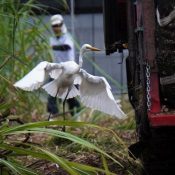
January 14, 2022 Ryukyu Shimpo
By John Matsumoto
On Okinawa’s main island and in the Yaeyama islands January 13, a high-pressure system from the Asian continent brought with it some chilly weather and a little rain. In the fields of Komesu, Itoman, where the sugarcane harvest is at its peak, a great white heron could be seen following along after a harvester cutting sugar cane, feeding itself by pecking earthworms and bugs from the ground.
According to Naoki Tamaki, 34, who was operating the harvester, the heron was part of a flock of 5-6 herons. “They didn’t seem scared of the machinery or people whatsoever,” he said, while the herons hunted for food nearby.
(English translation by T&CT and Sam Grieb)
Go to Japanese
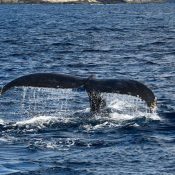
January 10, 2022 Ryukyu Shimpo
By Hirokazu Ohtsubo
Every year, from the end of December until the following April, humpback whales visit the waters of Kerama Islands to breed. During this whale watching season, whales have been spotted one after another in Zamami and Tokashiki Villages and the residents are all in a welcoming mood.
The Zamami Village Whale Watching Association gave its first whale watching boat tour of the season on December 28, which was originally slated for December 27 but was canceled due to high waves. The first whale sightings were reported on December 19, with more sightings since.
In the waters approximately 3 km south of Zamami’s Fukaji Island, three humpback whales, a male whale escorting a parent and a calf born last season, were seen swimming leisurely, surfacing to breathe at 10 to 20 minutes intervals.
Kiyoshi Miyagi, 61, a captain and a photographer, said, “I’m glad they come back safely like this every year. I was a little worried about the pumice stones, but I hope they can raise their children around the Kerama Islands peacefully.”
The association plans to offer whale watching tours until April 5. One staff at the administrative office commented, “It’s been a great start [to the season].”
A man in his twenties from Ishikawa Prefecture, who participated in the tour, said, “Right away we were able to see a calf and two adult whales. It was great. I would love to come back in February.”
(English translation by T&CT and Monica Shingaki)
Go to Japanese
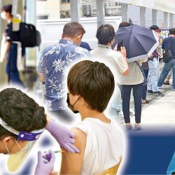
January 14, 2022 Ryukyu Shimpo
By Takuya Kayo
On January 13, it was revealed that at 90 hospitals in Okinawa Prefecture, including major medical facilities, that accept COVID-19 patients, there are 989 healthcare workers absent from work. Although 648 hospital beds had been reserved for COVID-19 patients, that number has been reduced by 17 to a total of 631 beds due to the staffing shortages. According to Toru Itokazu, the Chief Medical Officer of Okinawa, this is the first time that worker absences due to infectious disease have led to a reduction in the number of hospital beds reserved.
The breakdown of the 989 absent workers at the 90 hospitals is as follows: 45 doctors (14 COVID-positive), 494 nurses (152 COVID-positive), and 450 paramedics and office staff (106 COVID-positive). At 20 of the 21 major medical facilities in Okinawa, a total of 661 workers are absent. As of January 13, 14 hospitals have partially limited their emergency department, and 8 hospitals have restricted general outpatient care as a result of the successive absences. Itokazu says, “Infections are spreading rapidly, so it is very difficult to predict staff absences.”
In Okinawa, irreplaceable healthcare workers who have been in close contact with a COVID-positive individual may continue to report to work if they are fully vaccinated and test negative on daily antigen tests. According to a prefectural representative, no one in this category has tested positive at this time.
To address the present difficulties ensuring beds and managing hospital admissions caused by staffing shortages, on January 12, the prefecture restarted operations of a hospital admission waiting station for COVID-positive individuals in the southern part of Okinawa’s main island. On January 19, one overnight care facility with 80 rooms will open in Naha. This will bring the total number of such facilities in Okinawa Prefecture to nine, with a total of 932 rooms.
(English translation by T&CT and Ellen Huntley)
Go to Japanese
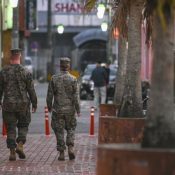
January 11, 2022 Ryukyu Shimpo
By Ryota ShimabukuroBy Ryota Shimabukuro [Central/Northern Okinawa] – Facing the spread of COVID-19 amongst U.S. service men and women stationed in Japan, restrictions against U.S. military personnel leaving their residence except for necessities began January 10, and they have all but disappeared from the streets of the town surrounding the bases. Combined with it being a weekday for the U.S. military, the streets in front of the bases gates were quieter than usual.
The new cluster of coronavirus cases began at the end of last year at Camp Hansen in Kin. On January 10, the base’s surrounding commercial district Shinkaichi had almost no soldiers walking the streets, but soldiers in camouflage could be seen training inside the fences surrounding the base.
On the night of January 7, the bars were bustling with activity and a group of around 20 soldiers could be seen walking through the streets, but on the 10th this scene had disappeared. One man who runs a restaurant in the area said with concern, “I have both doses of the vaccine, so I do feel somewhat safe, but I am a bit concerned about running a restaurant, where people will need to go without masks. Business will definitely drop due to the lockdown.” Another man who runs a restaurant commented, “There is nothing really that can be done at this time. I just hope that the coronavirus situation settles down quickly.”
One .U.S marine who described himself as an officer walking around Shinkaichi on January 7 gave a short explanation, saying he was “encouraging marines to follow the curfew.” On January 10, the were also some marines making similar rounds.
On January 8, a large number of U.S. military personnel could be seen shopping in Mihama, Chatan. However on January 10 only a few local families and couples could be seen. Fukuko Santos (in her 40’s) who works at a Thai restaurant, said “Usually we see some US military members even on weekdays at lunch time, but today there was almost nobody. With the coronavirus reducing the number of tourists as well, it has really had an effect on foot traffic. I hope the situation resolves itself quickly. (compiled by Ryota Shimabukuro)
(English translation by T&CT and Sam Grieb)
Go to Japanese
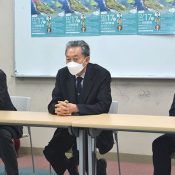
January 4, 2022 Ryukyu Shimpo
By Shinji Sano
On December 17, the East Asian Community Institute held a town meeting in Miyakojima City titled “Contemplating Miyako Island missile deployment and how the current situation in Miyako Island and the Nansei Islands might be affected by a Taiwan emergency.” About 50 city residents participated in the meeting and exchanged views about the impacts that missile deployment and a “Taiwan emergency” would have on the island.
Chairman of the East Asian Community Institute Yukio Hatoyama, journalist and director of said institute Hajime Takano, and former special researcher of the Cabinet Secretariat Kiyoshi Sugawa all arrived on Miyako Island for the meeting. These three gave speeches prior to exchanging views with the city residents. As concerns the strengthening of the Self-Defense Forces presence on the Nansei Islands pursued by the Japanese government, Hatoyama and the others criticized that this move is “progressing based on antiquated ideas” and emphasized that it is “unnecessary.”
Supposing that a Taiwan emergency did occur, Hatoyama and the others assessed that when it came time for Japan and the United States to enter the fray, tensions would not rise gradually with missiles maintained on both sides, but rather “there is a high probability that war would break out all at once.” In addition, they emphasized that “the U.S. military bases in Okinawa and SDF missile bases such as those on Miyako Island would be first on the radar in terms of being targets for attack by China,” and as such, “the presence of missiles on the island jeopardizes it.”
Before the meeting, the three speakers went to see Camp Miyakojima, the Bora Training Area with its ammunition depot, and Miyakojima Sub Base. The three speakers also warned that the distance between Bora Village and the ammunition depot is very short. Takano said, “It would be better to say the ammunition depot is in the village, it is ridiculous for it to be at such an unsuitable distance.”
(English translation by T&CT and Erin Jones)
Go to Japanese
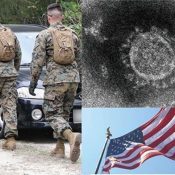
January 7, 2022 Ryukyu Shimpo
By Manabu Saito and Shoehi Tsukazaki
Tokyo – Minister for Foreign Affairs Yoshimasa Hayashi spoke with U.S. Secretary of State Anthony Blinken on the phone January 6, where he requested that the U.S. military thoroughly strengthen measures to prevent the spread of COVID-19, including restricting U.S. soldiers from going outside. With the omicron variant rapidly spreading throughout the U.S. military bases in Japan, the level of concern has been raised in all the municipalities that host a base, starting with Okinawa, and the Japanese government is finally pushing for more effective policies inside the U.S. bases.
Starting in May of last year, U.S. military personnel stationed in Japan who have received at least two doses of the COVID-19 vaccine have been allowed to go without a mask inside U.S. military bases.
On January 6, the U.S. military command in Japan increased their five-tier “Health Protection Condition Level” (HPCON) by one level up to the third, “Bravo.” From now, the U.S. military will implement the following policies for their personnel: 1. Everyone will be required to wear a mask until they are tested and receive a negative result, 2. Everyone who arrives in Japan must undergo a health inspection, and 3. Everyone must wear a mask when leaving the base.
Meanwhile at Camp Hansen, where they are experiencing community infections, they have been at level Bravo since December 17, however U.S. military personnel have been confirmed outside of the base without masks. Okinawa Prefecture asked both the Japanese and U.S. government to restrict people from leaving the base on December 21, but no steps were taken to make such a restriction.
The January 6 request from Hayashi did not extend to U.S. military personnel living off base, and it seems that additional adjustments to achieve more effective measures may also be requested.
According to the ministry of foreign affairs, in the meeting Blinken said, “’The health and safety of the area’s residents are very important to us. We will take the suggestion to the [U.S.] Department of Defense, and do everything we can to halt the spread of this disease.”
(English translation by T&CT and Sam Grieb)
Go to Japanese












 Webcam(Kokusai Street)
Webcam(Kokusai Street)


